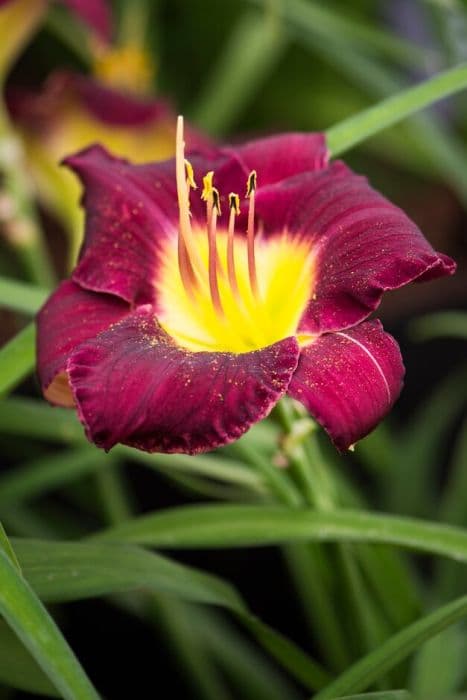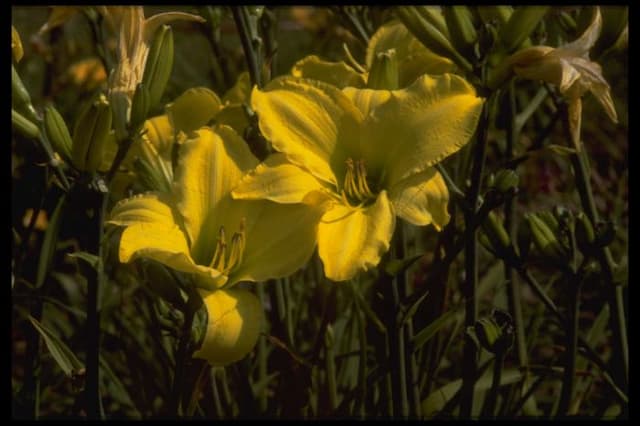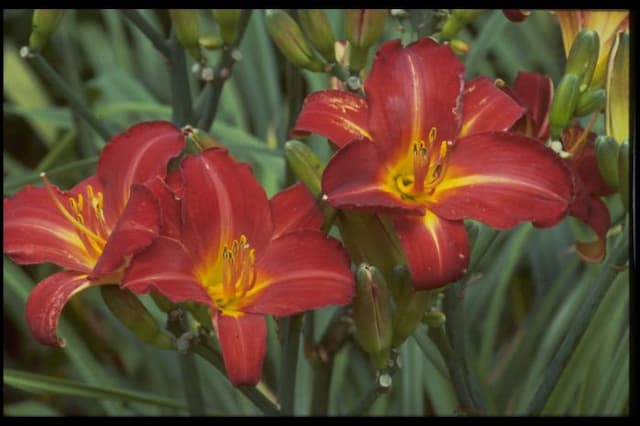Daylily Hemerocallis 'Pink Damask'

ABOUT
Hemerocallis 'Pink Damask' is a striking perennial plant known for its lush foliage and beautiful blooms. Commonly referred to as a Daylily, this cultivar is distinguished by its elegant, trumpet-shaped flowers that boast a delightful shade of soft pink, often with a subtle hint of blush or peach. The blossoms typically exhibit a gentle ruffling along the petal edges, adding to their charm and delicate appearance. Each flower has six petals and a contrasting throat, often in a yellow or greenish hue, which leads into the flower’s center. The leaves of the Daylily 'Pink Damask' are long and slender, emerging from the base of the plant in a graceful arching manner. They are bright green in color and provide a lush, grass-like backdrop for the stunning flowers. The plant produces multiple flower stalks, which rise above the foliage and showcase the blooms in an impressive display that adds a splash of color to any garden space. Daylilies are known for their individual flowers that typically last just one day, with several buds on each stalk ensuring a succession of blooms over a period of weeks in the growing season. The overall appearance of 'Pink Damask' is one of soft elegance, making it a favorite among gardeners who wish to create a serene and inviting landscape.
About this plant
 Names
NamesFamily
Hemerocallidaceae
Synonyms
Daylily, Common Daylily, Lemon Lily, Tiger Daylily
Common names
Hemerocallis 'Pink Damask'.
 Toxicity
ToxicityTo humans
The plant in question, known commonly as the daylily, is not generally considered toxic to humans. In fact, certain parts of daylilies are edible and have been consumed in various cultures as food. However, it's important to note that not all plants that resemble daylilies are safe for human consumption; true lilies, for example, can be toxic. As Hemerocallis 'Pink Damask' is a type of daylily, it would not typically cause poisoning in humans. Nevertheless, it is always advisable to be cautious and ensure proper identification of a plant before considering ingestion, as individual reactions can vary and there may be specific concerns for those with certain allergies or health conditions.
To pets
The daylily, while not toxic to humans, is potentially dangerous to certain pets, particularly cats. Ingestion of daylilies by cats can lead to acute kidney failure, which is a serious and potentially life-threatening condition. Symptoms of daylily poisoning in cats can include vomiting, lethargy, lack of appetite, and increased urination followed by a lack of urination as kidney failure progresses. If you suspect your pet has ingested any part of a daylily, it is critically important to seek veterinary care immediately. The prognosis is better the sooner treatment begins.
 Characteristics
CharacteristicsLife cycle
Perennials
Foliage type
Deciduous
Color of leaves
Green
Flower color
Pink
Height
2 feet (60 cm)
Spread
2 feet (60 cm)
Plant type
Herb
Hardiness zones
3
Native area
Asia
Benefits
 General Benefits
General Benefits- Easy to Grow: Hemerocallis 'Pink Damask', commonly known as Daylily, is known for its adaptability and ease of cultivation, thriving in a variety of climatic conditions.
- Drought Tolerance: Once established, Daylilies have good drought tolerance, making them suitable for xeriscaping or in regions with water scarcity.
- Low Maintenance: They require minimal care beyond initial planting and occasional watering, making them ideal for gardeners seeking low-maintenance landscaping options.
- Long Blooming: Daylilies can bloom for several weeks, sometimes with repeat blooming, providing long-lasting color in the garden.
- Attracts Pollinators: The colorful blooms attract butterflies and bees, which are beneficial for pollinating gardens.
- Variety of Uses: They are versatile and can be used in borders, flower beds, and as ground cover, or for controlling erosion on slopes.
- Pest Resistance: They are generally resistant to many pests and diseases, reducing the need for chemical treatments.
- Propagates Easily: Daylilies can be easily divided to produce new plants, making them economical and great for sharing with fellow gardeners.
- Adaptable to Soil Conditions: They can grow in a wide range of soil types, although they prefer well-drained soils.
- Colorful Addition: The 'Pink Damask' variety adds a soft pink hue to the garden palette, enhancing the visual appeal of any landscape design.
 Medical Properties
Medical PropertiesThis plant is not used for medical purposes.
 Air-purifying Qualities
Air-purifying QualitiesThis plant is not specifically known for air purifying qualities.
 Other Uses
Other Uses- Edible Flowers: The blooms of the daylily are edible and can be used in salads, soups, or as a garnish, providing a sweet taste and a crunchy texture.
- Natural Dye: The petals of the daylily can be used to create a natural dye for fabrics, yielding soft shades of pink and orange depending on the mordant used.
- Garden Design: Daylilies are often used in landscape design for their attractive foliage and ability to form dense clumps that can act as a ground cover, preventing soil erosion.
- Companion Planting: Daylilies can be planted alongside vegetables like tomatoes to deter pests, as their strong scent and tall foliage help to mask the scent of the veggies.
- Crafts: Dried daylily flowers can be incorporated into potpourris or used to make floral arrangements and wreaths due to their color and form.
- Photography: The vibrant flowers of the daylily provide an excellent subject for botanical photography, capturing the beauty of the bloom's detail and color.
- Wedding Decor: Fresh daylily flowers can be used in wedding bouquets, centerpieces, or as part of the décor for their soft colors and large, showy flowers.
- Culinary Presentations: The individual daylily petals can be used to add color and elegance to culinary presentations, especially on cakes or high-end dishes.
- Teaching Tool: Gardeners and educators use daylilies to teach principles of gardening, hybridization, and plant biology due to their ease of growth and hybridizing potential.
- Art Inspiration: The striking appearance of the daylily has inspired many artists and can be seen depicted in various forms of art, from oil paintings to watercolor illustrations.
Interesting Facts
 Feng Shui
Feng ShuiThe Daylily is not used in Feng Shui practice.
 Zodiac Sign Compitability
Zodiac Sign CompitabilityThe Daylily is not used in astrology practice.
 Plant Symbolism
Plant Symbolism- Longevity: The genus name "Hemerocallis" comes from the Greek words for "day" (hemera) and "beautiful" (kallos), referring to the flowers that typically last for only a day. Despite this, the plant keeps blooming with new flowers throughout its flowering season, symbolizing the idea of renewal and the transient nature of life and beauty.
- Motherhood: Daylilies, in general, have been associated with motherhood because of their prolific nature and their ability to endure and thrive in various conditions.
- Embracing Change: Since each flower lasts only a day, daylilies symbolize the acceptance of the fleeting nature of life. The ‘Pink Damask’ variety, with its recurring blooms, emphasizes the importance of embracing change and finding beauty in every moment.
- Femininity: The color pink is often associated with feminine qualities such as gentleness, grace, and happiness. The 'Pink Damask' variety, with its soft pink petals, could symbolize these feminine aspects.
 Water
WaterDaylilies, like the 'Pink Damask' daylily, should be watered deeply once a week, allowing the soil to dry out slightly between waterings. In the absence of rainfall, provide about 1 inch of water weekly. During the active growing season in spring and summer, they may need more frequent watering, especially if the weather is particularly hot or dry. Apply water directly to the soil to avoid wetting the foliage, which can encourage fungal diseases. For established plants, 1 to 1.5 gallons per week per plant should suffice, while newly planted daylilies may require slightly more frequent watering to establish a strong root system.
 Light
LightThe 'Pink Damask' daylily thrives in full sun but can tolerate partial shade. The ideal spot would provide at least 6 hours of direct sunlight each day. If planted in too much shade, the plant may produce fewer flowers and have weaker growth. Morning sun with afternoon shade can be beneficial in extremely hot climates to prevent the blooms from fading quickly.
 Temperature
TemperatureDaylilies, including the 'Pink Damask' variety, are adaptable to a wide range of temperatures but grow best when the temperature is between 60°F and 75°F. They can survive minimum winter temperatures down to -20°F and are hardy in USDA zones 3 through 9. During hot weather, they continue to perform well but may need additional watering to cope with the heat.
 Pruning
PruningPruning 'Pink Damask' daylilies involves removing spent flowers and flower stalks to encourage reblooming and maintain a tidy appearance. This should be done as soon as the flowers fade. In late fall or early spring, cut back the foliage to the ground to prepare for new growth. The best time for pruning is immediately after a bloom cycle completes or in early spring before the active growing season.
 Cleaning
CleaningAs needed
 Soil
SoilThe Daylily 'Pink Damask' thrives best in well-draining soil enriched with organic matter, such as compost or peat moss. Incorporating a balanced, slow-release fertilizer at planting time will benefit growth. This perennial prefers a soil pH ranging from 6.0 to 6.5, slightly acidic to neutral.
 Repotting
RepottingDaylilies, including 'Pink Damask', typically do not require frequent repotting. They can be left undisturbed for several years. However, if the clumps become overcrowded or the plant's vigour declines, they should be divided and repotted every 3 to 5 years in the spring or fall.
 Humidity & Misting
Humidity & MistingDaylilies, including 'Pink Damask', are quite adaptable and do not require specific humidity levels. They can thrive in the average outdoor humidity found in their growing zones. Providing them with good air circulation will help prevent any humidity-related issues.
 Suitable locations
Suitable locationsIndoor
Place Daylily 'Pink Damask' near a window for bright, indirect light.
Outdoor
Plant Daylily 'Pink Damask' in full sun to partial shade area.
Hardiness zone
3-9 USDA
 Life cycle
Life cycleDaylily 'Pink Damask' starts its life as a seed, which upon germination, develops a small root system and foliage. The young plant, or seedling, grows to form a clump with strap-like leaves, gradually reaching maturity and developing its characteristic tall flower stalks. Flowering occurs in early to mid-summer, with each trumpet-shaped, pink bloom typically lasting only a single day, hence the common name "daylily." After blooming, the plant sets seed, if pollination has occurred, while also producing underground storage structures known as rhizomes which allow for vegetative propagation and overwintering. As the season progresses into fall, the foliage begins to die back in preparation for dormancy over the winter. In spring, the daylily emerges again from the rhizomes, ready to restart the cycle with new growth.
 Propogation
PropogationPropogation time
Early Spring to Summer
Propogation: The most popular method of propagating the Daylily 'Pink Damask' is through division. This is typically done in the early spring or fall when the plant is not actively blooming. To propagate by division, dig up the entire clump of Daylilies, making sure to keep a good amount of soil around the roots. Using a sharp spade or knife, the clump is then carefully separated into smaller sections, each with several fans of leaves and a portion of the root system. These divisions can be immediately replanted into a well-prepared garden bed or container, spaced about 18 to 24 inches (approximately 45 to 60 centimeters) apart to allow adequate room for growth. Water the new divisions thoroughly to settle the soil around the roots and help establish them in their new location. This method is straightforward and ensures that the Daylily 'Pink Damask' maintains its health and vigor, allowing gardeners to expand their display or share with others.









